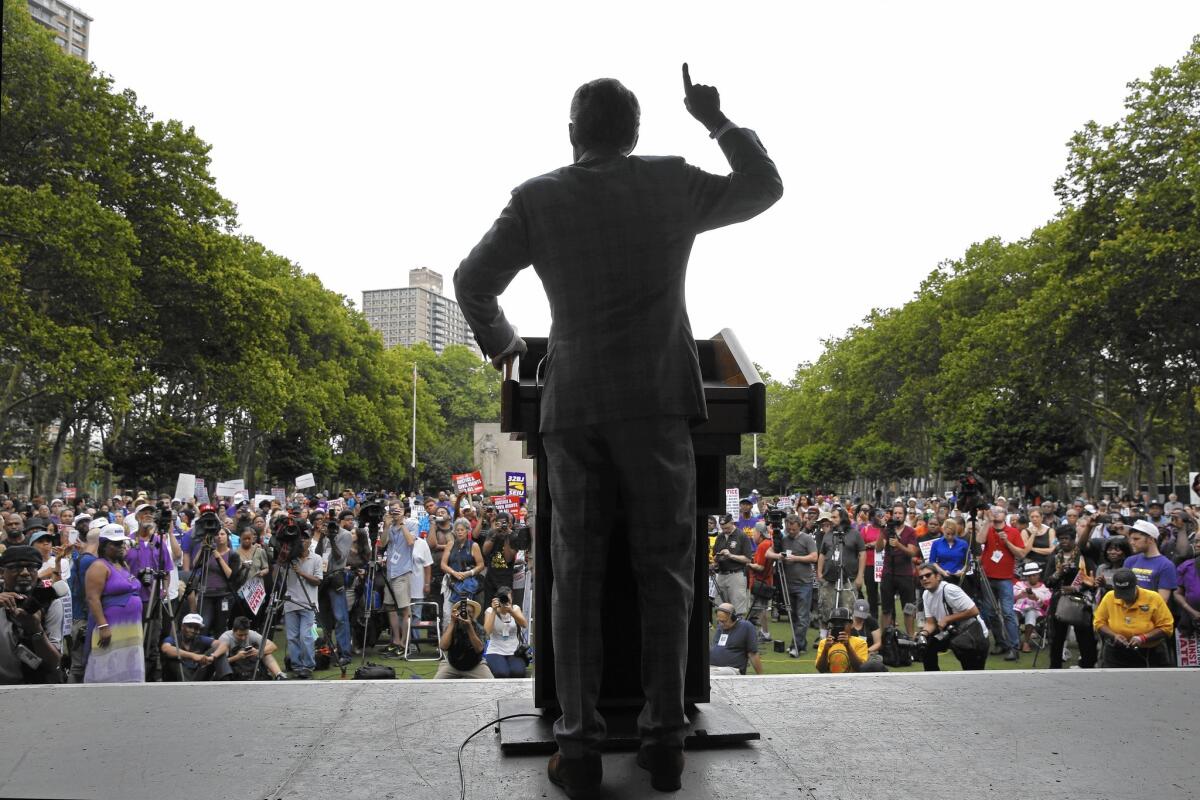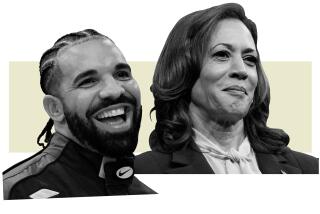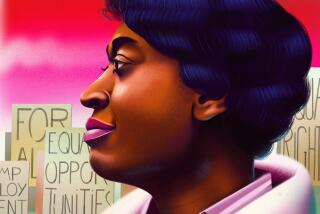Al Sharpton, still polarizing but no longer a political outlier

The Rev. Al Sharpton speaks at a rally in Brooklyn, N.Y., on July 18 commemorating the one-year anniversary of the death of Eric Garner.
Reporting from NEW YORK — It was a blazing hot day, but Al Sharpton didn’t break a sweat as he waited to take the stage at a Brooklyn rally, dressed as usual in a perfectly cut suit and tie, his arms crossed and his leather-clad feet planted firmly, almost statue-like, on the ground.
The crowd was there to remember Eric Garner, an unarmed black man who died one year earlier in a scuffle with a white police officer on Staten Island, and Sharpton was one of many speakers. But Sharpton had called this gathering, and as he stood beneath a tarp out of sight of the fidgety masses, it was clear he was in charge.
He checked his watch. He checked to make sure Garner’s widow, Esaw, was by his side. He checked his phone for messages, and he eyed the other speakers as if silently timing them.
When it was his turn to speak, Sharpton strode to the microphone, arms held up as if in victory. He scoffed at critics who he said had expected people to protest Garner’s death “for a few weeks, and then move on.”
“But we’re still here,” he bellowed in his gravelly baritone. “We’re not going anywhere.”
The same could be said for Sharpton, who has morphed from political outlier to powerful insider with access to the president, the mayor and the police commissioner, and who jets around the country railing against police abuse and racial profiling.
“This is someone who has gone from velour tracksuits and gold medallions to business suits and a TV show on a major network,” said Christina Greer, a political science professor at Fordham University and longtime Sharpton observer.
NEWSLETTER: Get the day’s top headlines from Times Editor Davan Maharaj >>
During Sharpton’s most controversial days, in the 1980s and early ‘90s, critics slammed the Brooklyn-born Baptist minister as a troublemaker who fueled racial animosity plaguing the city.
In 1984 he led protests demanding prosecution of Bernhard Goetz, a white man who shot four black teens he said tried to mug him on the subway. Two years later, Sharpton rallied marchers after a white mob assaulted three black men in the Howard Beach section of Queens.
Sharpton rocketed to national attention the following year when he became the most visible and vocal supporter of Tawana Brawley, a black 15-year-old who accused six white men of sexually assaulting her, smearing feces on her body and carving racial epithets into her skin. A grand jury determined she had made up the story.
“That’s a blemish that will never go away,” Greer said of the incident’s effect on Sharpton’s image.
It made him politically hazardous to most white lawmakers, but it did not deter Sharpton from taking on more cases.
In recent years, killings of unarmed African Americans that have ignited public outrage have provided a fresh pulpit for Sharpton: Trayvon Martin, a 17-year-old shot in Florida in 2012; Garner, 43, who died in July 2014; Michael Brown, an 18-year-old shot by a white policeman in Ferguson, Mo., three weeks after Garner died; and several more since Brown.
“He is just a genius at inserting himself into national conversations,” Greer said. “You’d be ill-advised to underestimate this man.”
Sharpton, 60, couldn’t agree more.
He is as polarizing as ever, perhaps more so now in this era of leaderless movements such as Black Lives Matter, which see Sharpton’s tightly controlled National Action Network as outdated.
But Sharpton is also as prominent as ever, leading weekly rallies at the network’s Harlem headquarters, hosting a radio show whose recent guests included Hillary Rodham Clinton, delivering eulogies for Garner and Brown, and attending funerals in June for victims gunned down in a Charleston, S.C., church by a man authorities say is a white supremacist.
His MSNBC show “PoliticsNation” is on five nights a week and in its fourth year on the air.
“They said I wouldn’t be on four weeks,” Sharpton cracked as he relished July ratings showing the network beating CNN in his time slot.
Sharpton was in his MSNBC office, which is a reflection of him: compact and neat.
He is rail thin, almost bird-like, thanks to a diet of wheat toast and salads and a daily workout regimen that begins shortly after he rises at 4:30 a.m.
His desk was clear except for a computer, a signed picture of Nelson Mandela and a plastic red nose Sharpton had saved from Red Nose Day, an anti-poverty event. Framed newspaper and magazine pieces about Sharpton covered the walls. “My Pal Al,” read the banner headline on a New York Post cover featuring a photograph of Sharpton shaking hands with President Obama and dominating the wall behind Sharpton’s desk.
The White House’s public relationship with Sharpton is perhaps the most striking evidence of Sharpton’s evolution, but it is not the only one. The activist also enjoys relationships with New York’s most powerful leaders, including Gov. Andrew Cuomo, who ducked out of a charity gala hosted by the archbishop of New York in October to drop by Sharpton’s 60th birthday bash at the swank Four Seasons restaurant.
In April, at the opening of the annual National Action Network convention, Mayor Bill de Blasio hugged Sharpton onstage. Obama has twice been the convention’s keynote speaker, in 2011 and 2014.
Sharpton insists he has not changed that much other than his obvious physical transformation, which includes a more than 100-pound weight loss and an elegant new wardrobe. He says that society has changed and that the views he espoused in the 1980s and ‘90s about racial profiling, “stop and frisk” tactics and police abuse are no longer considered radical.
But Sharpton also has widened his repertoire to emphasize mainstream issues such as healthcare, education, same-sex marriage and immigration.
All of them affect blacks, and advances in those areas could be lost if a Republican wins the White House, Sharpton said after delivering his weekly sermon at the House of Justice, the network’s headquarters.
Losing the White House is his biggest fear, and his sermon had focused on the need for African Americans to prevent that by being politically active and not giving in to despair despite a national landscape still rife with inequality.
Sharpton was operating on about four hours’ sleep, having flown in that morning from leading a rally in Cleveland to demand law enforcement reform. But he spoke without notes for more than an hour, his voice booming through the cavernous room.
The sermon turned personal as Sharpton remembered his mother, who scrubbed floors, directing him to wait by the mailbox on the first and 16th of each month to ensure nobody stole their welfare checks or food stamps.
“It wasn’t my fault how I was born, but it’s going to be my fault how I leave here,” he told the mainly black crowd of about 200, exhorting them to vote.
“Everything we have fought for is at risk,” he said in an interview after the sermon. “I don’t think there’s a sense of urgency. If you get one more Republican Supreme Court justice, they will have locked a majority around voting rights, around immigration, around affordable housing. We will lose a lot of what we’ve gained in the last 50 years.”
He worries about the effect on black Americans when Obama leaves office and they no longer have the image of a black president and his family crossing the White House lawn.
“If you think there’s a disconnect now, imagine what it’ll be like for the next president,” said Sharpton, who sees seasoned leaders such as himself as key to shaking up elected officials.
That has put him at odds with young African American activists who deride him as old school and self-serving. Powerful, centralized leaders are not necessary, they say, when social media can produce huge protests anywhere in minutes.
“That’s one reason I feel like a decentralized movement is one of the best options,” said Johnetta Elzie, a 26-year-old from St. Louis who openly clashed with Sharpton’s people during a protest in December in Washington, D.C., to demand police reform. Elzie and a few other protesters climbed onstage and demanded to speak.
“We started this. There should be young people all over this stage,” said Elzie, who gained prominence in Ferguson for using social media and a newsletter to document events there after Brown’s death. Elzie and DeRay Mckesson went on to launch Mapping Police Violence, an online accounting of civilians killed by police.
Both eschew Sharpton’s style of leadership, which they said can slow things down.
“People can do the work in each city and they’re not waiting for the command from one person,” Elzie said.
Greer agrees that social media have undercut the need for strong centralized leaders. She also said the face of black activism — long represented by male clergy such as Martin Luther King Jr. and Jesse Jackson — has changed.
“When you look at the people coming up now, they identify as queer, there are a lot of black women. It doesn’t look like the kind of black leadership we had in the past,” she said.
This has not escaped Sharpton’s movement. At the April convention, the leader of the network’s Iowa chapter, Frantz Whitfield, said the organization needed to reach out to young people.
“A lot of the older people and the adults know Rev. Sharpton, but if you ask the young people who Rev. Sharpton is, a lot of them don’t know,” Whitfield said.
Indeed, most faces at the House of Justice rallies tend to be middle-aged and older. Julian Alexander Hemmings, who is 16 and lives in New York City, was an exception at a July gathering, and he joined the network that day. His parents are active in civil rights causes, and that is how Hemmings became familiar with Sharpton.
“Al Sharpton to me is the sort of agent or catalyst who can move us forward,” said Hemmings, who thinks leaderless groups lack the momentum to force change.
“We need people who can bring ideas into practice. We need action. Twenty people, 40 people, 60 people in one room bickering won’t get things done,” he said. “We need someone to be a kind of captain.”
For him, that captain is Sharpton, or Rev, as most people call him.
Sharpton insists he has no issue with his youthful critics. “If that’s your model and it works, fine,” he said, adding that his network has plenty of high-ranking organizers much younger than he is.
But Sharpton shows no sign of slowing down, and if he is grooming anyone to replace him, he isn’t saying.
“I’m just a working person,” he said.
Twitter: @tinasusman
ALSO:
James Holmes prosecutor talks about holdout juror and the future of the death penalty
How one big promise Jeb Bush made to Florida’s economy has yet to deliver
States may not have legal right to cut Medicaid funds to Planned Parenthood clinics
More to Read
Sign up for Essential California
The most important California stories and recommendations in your inbox every morning.
You may occasionally receive promotional content from the Los Angeles Times.











